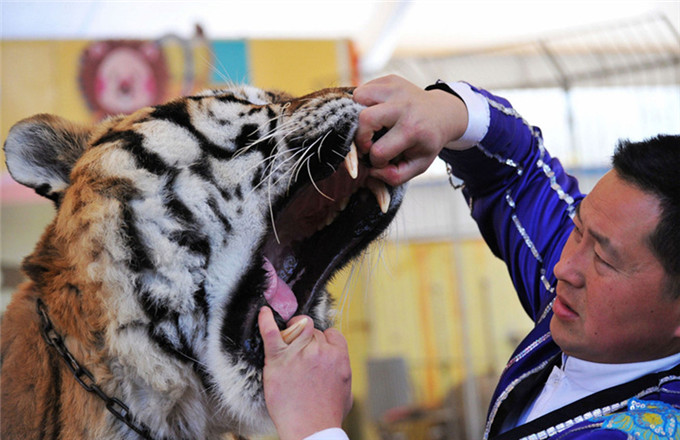Breeding pandas - struggle bears fruit
The International Union for the Conservation of Nature announced in early September that China's giant panda has been downgraded from "endangered" to "vulnerable" on the global list of species at risk of extinction, saying evidence from national surveys indicates the previous population decline has been reversed.
But the State Forestry Administration said in an official statement: "It is too early to say the giant panda is no longer endangered."
China's fourth panda census, the results of which were released in 2015, showed 1,864 wild pandas and 375 captive pandas worldwide as of the end of 2013. That compares with 1,596 wild pandas and 164 captive pandas worldwide in the third census carried out from 2000 to 2002.
But 24 of the 33 groups of wild pandas found in the fourth census - whose results were released in February last year - are endangered, with some groups having fewer than 30 pandas. Eighteen groups have fewer than 10 pandas each and are in danger of extinction.
Zhang Hemin, chief of the China Conservation and Research Center for the Giant Panda in Wenchuan county, in Sichuan province, was against the downgrading but said it showed an acknowledgment of China's achievements in panda breeding.
Typically, visitors do not expect to see lots of pandas in Zhang's center.
As Wan Yongqing, a middle-aged panda fan from Beijing says: "Since my childhood, I have been told pandas are an endangered species."
But visitors are pleasantly surprised when they visit the center thanks to the painstaking work of the center's researchers over the 15 years to solve the three main problems in breeding pandas in captivity - estrus, mating and nursing.
Through their work, the center has rescued the animals from the brink of extinction and built up the number of captive pandas there from a mere 10 to 216.
"It used to be difficult for captive pandas to become ruttish and mate, and for their cubs to survive. But from 1992 to 2006, our researchers solved all three problems, " says Zhang.
In 1980, an agreement between the World Wide Fund for Nature and the Chinese government led to the establishment of the center in the Wolong National Natural Reserve in Wenchuan.
Completed in 1983, the center is now the world's largest panda conservation and research organization.
Researchers at first did not understand the pandas' habits. And, thinking that they preferred a solitary life, researchers kept each panda isolated in a tiny den and fed them only bamboo.
As a result the pandas became depressed and had difficulty becoming ruttish, says Zhang.
Then, in the course of studies initiated in 1992, researchers provided captive pandas with more opportunities to communicate socially with each other and play.
Male and female pandas were then swapped into the dens of the opposite sex so that each would know the smell of the other.
"We also showed sexually mature pandas videos of their peers having sex, which they could learn in the wild but not in captivity, " says Zhang.
In the wild, pandas eat bamboo. They seek out the best plants - the ones receiving adequate sunshine and providing the best nutrition.
"Since we could not provide that kind of bamboo for the captive pandas, we created a biscuit rich in trace elements and vitamins for them," says Zhang.
Also, wild pandas stay active for many hours each day. And, to emulate their natural environment, researchers tried putting the biscuits in places the pandas could not find easily, aiming to get them to move around.
"To make them play, we froze fruits before giving them to the pandas. They had to play with the fruits until they thawed if they wanted to eat them," says Zhang.
Also, earlier, many newborn panda cubs died because of abandonment.
The abandonment used to happen because 50 percent of the newborns are typically twins and the mother would end up caring for only one.
A mother panda would first try to care for both babies, but several hours later, when she realized that she could not, she would abandon one baby.
If she tried to support both, both will die. So the mothers deserted one baby even if it cried, says Zhang.
Researchers at first did not know how to handle the abandonment problem. And the death rate was high.
So, they settled on a course that was part philanthropy and part trickery.
They would take away the deserted baby and feed it milk.
Then, they would switch it with the favored cub from time to time. So the mother unwittingly supported both.
Researchers also emulated the mother panda in other ways.
The mother would lick different parts of the newborn cub, including its anus to get its droppings out.
Researchers used a cotton stick to mimic the mother while touching the deserted cub to get the droppings out.
This ensured the cubs' survival, says Zhang.
With the three primary obstacles hindering the breeding of captive pandas now overcome, the center has been able to develop a self-sustaining and growing panda population.
It is now home to nearly 60 percent of the world total.
And with the world's largest captive panda population, the center no longer catches wild pandas for research. Instead, it sends captive pandas into the wild aiming to enlarge the natural panda population.
Tao Tao, a 2-year-old male panda from the center, was released into the wild in the Liziping Nature Reserve in Shimian county, in Sichuan, in October 2012. He was discovered in a tree more than 3,000 meters above sea level on Oct 30, 2013.
A veterinarian tranquilized the frightened bear with a rifle dart, and Tao Tao fell into a net. A blood test showed the panda was in good health, says Yang Zhisong, an expert in zoology at China West Normal University in Nanchong, in Sichuan, who was on the scene.
Tao Tao weighed 42 kg when he was released in 2012. When he was found a year later, he had gained at least 10 kg, says Yang.
Since 2006, the center has released five captive pandas into the wild. Three survive according to the GPS tags attached to them.
huangzhiling@chinadaily.com.cn
|
Clockwise from top: A one-month-old panda cub Hua Sheng plays with its mother; Hua Sheng is the fi rst panda cub born at the Shanghai base of the China Conservation and Research Center for the Giant Panda; Tao Tao, a two-year-old male panda, was released into the wild in the Liziping Nature Reserve in Sichuan in October 2012. Photos By Lai Xinlin And Heng Yi / For China Daily |




















